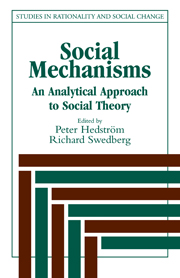Book contents
- Frontmatter
- Contents
- ACKNOWLEDGMENTS
- LIST OF CONTRIBUTORS
- 1 Social mechanisms: An introductory essay
- 2 Social mechanisms and social dynamics
- 3 A plea for mechanisms
- 4 Real virtuality
- 5 Concatenations of mechanisms
- 6 Do economists use social mechanisms to explain?
- 7 Social mechanisms of dissonance reduction
- 8 Social mechanisms without black boxes
- 9 Is sociological theory too grand for social mechanisms?
- 10 Theoretical mechanisms and the empirical study of social processes
- 11 Monopolistic competition as a mechanism: Corporations, universities, and nation-states in competitive fields
- 12 Rational imitation
- AUTHOR INDEX
- SUBJECT INDEX
5 - Concatenations of mechanisms
Published online by Cambridge University Press: 24 March 2010
- Frontmatter
- Contents
- ACKNOWLEDGMENTS
- LIST OF CONTRIBUTORS
- 1 Social mechanisms: An introductory essay
- 2 Social mechanisms and social dynamics
- 3 A plea for mechanisms
- 4 Real virtuality
- 5 Concatenations of mechanisms
- 6 Do economists use social mechanisms to explain?
- 7 Social mechanisms of dissonance reduction
- 8 Social mechanisms without black boxes
- 9 Is sociological theory too grand for social mechanisms?
- 10 Theoretical mechanisms and the empirical study of social processes
- 11 Monopolistic competition as a mechanism: Corporations, universities, and nation-states in competitive fields
- 12 Rational imitation
- AUTHOR INDEX
- SUBJECT INDEX
Summary
Introduction
I take “mechanisms” to be hypothetical causal models that make sense of individual behavior. They have the form, “Given certain conditions K, an agent will do x because of M with probabilityp.”M refers either to forms of reasoning governing decision making (of which rational choice models are a subset) or to subintentional processes that affect action both directly (as impulsiveness) or by shaping preferences or beliefs.
Two other meanings may be attached to “mechanisms, ” as suggested by Hedstrdm and Swedberg in Chapter 1 of this volume. The first refers to models of interaction among individuals that generate particular social outcomes (the micro-to-macro case in their terminology). We construct these models to explain social phenomena such as markets, inequality, institutional performance, collective action, and so forth. Interaction models are predicated on individual-level mechanisms. The Prisoner's Dilemma, for instance, predicts a suboptimal solution by assuming self-interested and rational agents. If people cooperate when the hypothetical mechanism predicts they should not, as many experiments in social psychology have found (cf., e.g., Thaler 1994, Ch. 2), one is forced to search for other mechanisms. The second meaning refers to “macro” conditions that, via a given individual mechanism, can affect, say, beliefs or desires and, through those, behavior. Once again, these models are predicated on individual- level mechanisms. If an increase in opportunities for upward mobility leads to an increase in the number of people who feel more rather than less frustrated with the promotion system, we have a puzzling correlation.
- Type
- Chapter
- Information
- Social MechanismsAn Analytical Approach to Social Theory, pp. 102 - 124Publisher: Cambridge University PressPrint publication year: 1998
- 71
- Cited by



